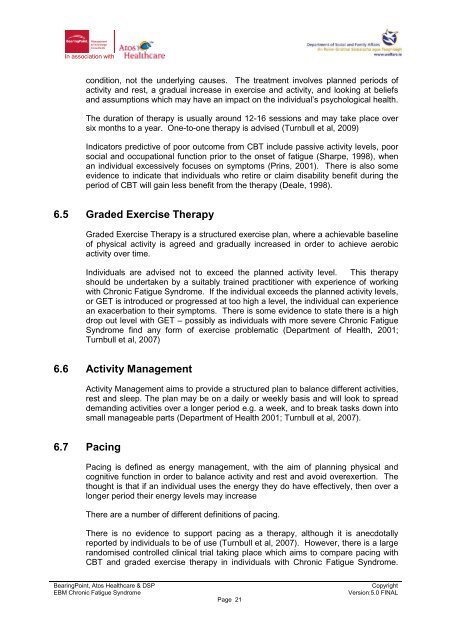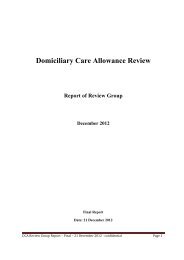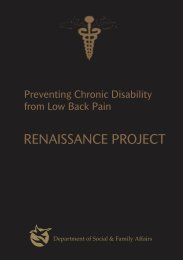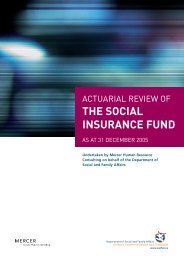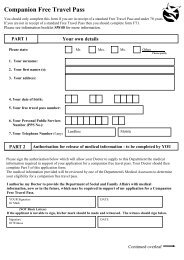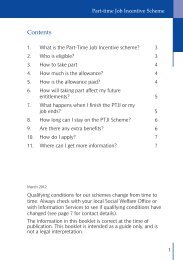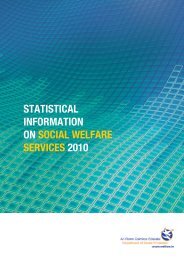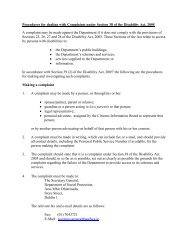Chronic Fatigue Syndrome - Welfare.ie
Chronic Fatigue Syndrome - Welfare.ie
Chronic Fatigue Syndrome - Welfare.ie
Create successful ePaper yourself
Turn your PDF publications into a flip-book with our unique Google optimized e-Paper software.
In association withcondition, not the underlying causes. The treatment involves planned periods ofactivity and rest, a gradual increase in exercise and activity, and looking at bel<strong>ie</strong>fsand assumptions which may have an impact on the individual’s psychological health.The duration of therapy is usually around 12-16 sessions and may take place oversix months to a year. One-to-one therapy is advised (Turnbull et al, 2009)Indicators predictive of poor outcome from CBT include passive activity levels, poorsocial and occupational function prior to the onset of fatigue (Sharpe, 1998), whenan individual excessively focuses on symptoms (Prins, 2001). There is also someevidence to indicate that individuals who retire or claim disability benefit during theperiod of CBT will gain less benefit from the therapy (Deale, 1998).6.5 Graded Exercise TherapyGraded Exercise Therapy is a structured exercise plan, where a ach<strong>ie</strong>vable baselineof physical activity is agreed and gradually increased in order to ach<strong>ie</strong>ve aerobicactivity over time.Individuals are advised not to exceed the planned activity level. This therapyshould be undertaken by a suitably trained practitioner with exper<strong>ie</strong>nce of workingwith <strong>Chronic</strong> <strong>Fatigue</strong> <strong>Syndrome</strong>. If the individual exceeds the planned activity levels,or GET is introduced or progressed at too high a level, the individual can exper<strong>ie</strong>ncean exacerbation to their symptoms. There is some evidence to state there is a highdrop out level with GET – possibly as individuals with more severe <strong>Chronic</strong> <strong>Fatigue</strong><strong>Syndrome</strong> find any form of exercise problematic (Department of Health, 2001;Turnbull et al, 2007)6.6 Activity ManagementActivity Management aims to provide a structured plan to balance different activit<strong>ie</strong>s,rest and sleep. The plan may be on a daily or weekly basis and will look to spreaddemanding activit<strong>ie</strong>s over a longer period e.g. a week, and to break tasks down intosmall manageable parts (Department of Health 2001; Turnbull et al, 2007).6.7 PacingPacing is defined as energy management, with the aim of planning physical andcognitive function in order to balance activity and rest and avoid overexertion. Thethought is that if an individual uses the energy they do have effectively, then over alonger period their energy levels may increaseThere are a number of different definitions of pacing.There is no evidence to support pacing as a therapy, although it is anecdotallyreported by individuals to be of use (Turnbull et al, 2007). However, there is a largerandomised controlled clinical trial taking place which aims to compare pacing withCBT and graded exercise therapy in individuals with <strong>Chronic</strong> <strong>Fatigue</strong> <strong>Syndrome</strong>.BearingPoint, Atos Healthcare & DSPEBM <strong>Chronic</strong> <strong>Fatigue</strong> <strong>Syndrome</strong>Page 21CopyrightVersion:5.0 FINAL


